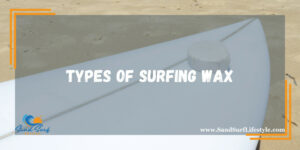Surfing is more than just riding the waves; it’s a harmonious dance with nature’s elements. One of the most crucial aspects of this art is having the right equipment, and when it comes to your surfboard, nothing can be more vital than choosing the best surfing wax. The right wax can make the difference between hanging ten with grace and wiping it out in a spectacular fashion.
Types of Surfing Wax

Cold Water Wax
Surfing in colder waters presents unique challenges, and choosing the right wax is crucial for optimal performance. Cold water wax is specially formulated to excel in lower temperatures, where other waxes may lose their grip. It boasts a composition that includes harder waxes and additives designed to enhance both grip and durability, ensuring you stay securely planted on your board even when the ocean chills your toes. Whether you’re tackling the waves off the coast of Northern California or exploring the rugged beauty of the Pacific Northwest, cold water wax is a must-have addition to your surf kit, guaranteeing an enjoyable and safe experience.
Warm Water Wax
When you find yourself in the warm embrace of tropical waters, your choice of wax can significantly impact your surfing experience. Warm water wax emerges as the ideal companion for these balmy conditions. Its softer consistency makes it a breeze to apply, even in the hottest climates, and it excels at providing the exceptional traction required for agile maneuvers on your board. If you are fortunate enough to ride the waves in idyllic destinations like Bali or Hawaii, warm water wax should unquestionably be your wax of choice, offering the perfect balance of ease of use and performance on those sun-soaked swells.
Base Coat Wax
The foundation of a strong wax job often begins with a base coat of wax. This essential component provides a stable and reliable groundwork for the application of your primary topcoat wax. Its primary function is to extend the lifespan of your wax job, ensuring it remains intact and effective over time. Base coat wax typically boasts a harder and more stable composition than standard wax, making it an ideal candidate for creating a robust bond between your surfboard and the topcoat wax. By starting with a base coat, you’re investing in the longevity and durability of your wax job, allowing you to ride the waves with confidence and style.
To learn more about the best wax for maximum performance, check out this article.
Factors Influencing Your Choice
Water Temperature
The water temperature at your surf spot plays a pivotal role in determining the type of wax you should use. It’s a fundamental factor that impacts your grip on the board. In colder waters, where the temperature can send chills down your spine, opting for cold water wax is a smart choice. This wax remains tacky in lower temperatures, preventing it from becoming too hard and slippery, thus ensuring you maintain a firm hold on your board. Conversely, when you’re catching waves in tropical paradises with warmer waters, warm water wax is your go-to option. Its softer consistency thrives in hot climates, providing the essential grip you need for smooth maneuvers.
Water Salinity
Water salinity, often overlooked, can significantly influence the performance of your surf wax. In areas with varying salinity levels or brackish water, the stickiness of your wax may fluctuate. To counteract this, consider using a versatile wax that can adapt to changing conditions. A wax designed to maintain its grip across a range of salinity levels ensures a consistent experience, allowing you to surf with confidence, no matter the water’s saltiness. By factoring in water salinity, you can fine-tune your wax choice and enjoy a more reliable and enjoyable ride.
Brand and Formulation
The world of surf wax is brimming with different brands, each offering unique formulations and ingredients. Surfers often develop strong preferences for specific brands, drawn to their consistency and performance. Brand loyalty runs deep in the surfing community, with enthusiasts swearing by their chosen labels. However, there’s also room for exploration and experimentation. Trying out various brands and formulations can be enlightening, helping you discover the perfect match for your surfing style and preferences. So, while some surfers find solace in familiarity, don’t hesitate to embark on a wax adventure and uncover the ideal blend that suits you best.
Application Techniques
The Right Temperature
Achieving the optimal temperature for applying surf wax is essential for a successful wax job. Wax performs at its best when it’s just right. If your wax is too cold and hard, it won’t spread smoothly, and if it’s too warm and soft, it can become messy. To find that sweet spot, consider leaving your wax in the sun for a few minutes, allowing it to soften slightly. Alternatively, you can use a wax comb to roughen it up, ensuring it’s at the perfect consistency for effortless application. Mastering the art of temperature control is a valuable skill for any surfer.
Even Application
Even applying wax to the areas of your surfboard where your feet will rest is crucial for consistent traction. An uneven application can result in patches of reduced grip, potentially leading to slips and wipeouts. To ensure an even spread, take your time when waxing your board, applying pressure consistently across the surface. It’s not just about aesthetics; it’s about safety and performance. An evenly waxed board allows you to execute maneuvers with confidence, knowing your feet will find secure placement wherever they land.
Wax Patterns
Many surfers have their preferred wax application patterns, such as a cross-hatch or circular motion. These patterns serve multiple purposes, from ensuring even distribution to enhancing grip. Experimenting with different patterns can be an insightful journey to discover what feels most comfortable and effective for you. Some patterns may provide better traction in specific conditions, so having a repertoire of techniques can be advantageous. Ultimately, your choice of wax pattern is a personal one, reflecting your unique style and preferences on the waves.
Maintenance
Your commitment to maintaining your wax job directly impacts your surfing experience. Over time, wax can wear down or become less effective, particularly after many sessions in the water. Regular maintenance is essential. Use a wax comb to gently roughen up the wax surface, revitalizing its grip. If your wax is significantly deteriorated, applying a fresh coat is a smart move. Proper maintenance not only ensures that your board performs optimally but also extends the life of your wax job, saving you time and effort in the long run.
Top Surf Wax Brands
Sex Wax
In the world of surf wax, Sex Wax is an iconic and respected name. It has earned its place as a household name in the surfing community, thanks to its consistent performance and instantly recognizable packaging. Sex Wax offers a diverse range of wax products tailored to different water temperatures and conditions, catering to the needs of surfers worldwide. Whether you’re tackling cold or warm waters, they have you covered. Additionally, Sex Wax goes beyond the traditional wax offerings, delving into unique products like base coat wax and even air fresheners in their signature scents, adding a touch of nostalgia to every surf session.
Sticky Bumps
Sticky Bumps is another renowned brand that enjoys a loyal following among surfers. They have established themselves as a trusted choice for surf wax, providing a variety of options tailored to different water temperatures and conditions. What sets Sticky Bumps apart is their user-friendly color-coded packaging, making it easy for surfers to select the right wax for the day’s conditions at a glance. This thoughtful design simplifies the waxing process and ensures that you’re always well-prepared for the surf, regardless of the water temperature or location.
Mrs. Palmer’s
For environmentally-conscious surfers, Mrs. Palmer’s is a brand that aligns with their values. Mrs. Palmer’s has gained popularity for its commitment to sustainability and the environment. Their surf waxes are crafted from natural ingredients, making them a more eco-friendly choice. This eco-conscious approach doesn’t compromise performance, as Mrs. Palmer’s offers a selection of waxes suitable for various water temperatures, ensuring that surfers can ride the waves responsibly without sacrificing grip or quality. Mrs. Palmer’s represents a brand that not only cares about your surfing experience but also the well-being of our oceans and planet.
Pro Tips for Waxing Your Board

Keep It Cool
Transporting your surfboard in hot weather requires careful consideration. Exposure to direct sunlight and excessive heat can have adverse effects on your wax job. High temperatures can cause the wax to melt and become messy, rendering it less effective. To prevent this, try to keep your board shaded during transport. Utilize a board bag or cover it with a towel or cloth when not in use. This simple precaution will help preserve your wax’s consistency, ensuring it’s ready to provide optimal grip when you hit the water.
Cleanliness is Key
A clean slate sets the stage for an effective wax application. Before adding fresh wax to your board, take the time to thoroughly clean it, removing any remnants of old wax, dirt, or debris. A clean surface ensures better adhesion, allowing the new wax to bond securely to the board. Use a wax comb or scraper to gently remove the old wax, followed by a wipe-down with a cloth or paper towel. This diligent approach not only enhances your grip but also maintains the integrity of your wax job for a more enjoyable surf session.
Wax Combs and Brushes
Wax combs and brushes are invaluable tools for maintaining the texture and grip of your surf wax. These accessories serve multiple purposes in your surf kit. They can help evenly distribute wax, ensuring a consistent and reliable grip on your board. Additionally, wax combs and brushes are effective in removing old wax, making it easier to prepare the board for a fresh application. Investing in a high-quality wax comb or brush is a wise choice, as it contributes to the longevity of your wax job and ensures that you get the most out of every session.
Layering
Some surfers opt for a layering technique when waxing their boards, especially in high-impact areas like the tail. Layering involves applying multiple coats of wax on top of each other. This approach can provide extra grip and extend the lifespan of your wax job, particularly in spots that receive the most pressure during maneuvers. When layering, be mindful not to overdo it, as excessive wax can create a sticky mess. Experiment with the thickness and number of layers to find the right balance that enhances your board’s performance while maintaining a clean and efficient wax job.
Waxing Alternatives
Traction Pads
Traction pads have gained popularity as an alternative to traditional surf wax. These adhesive pads can be applied directly to your surfboard’s deck, eliminating the need for wax altogether. Traction pads offer several advantages, the most notable being consistent grip. Unlike wax, which can become less effective over time, traction pads maintain their stickiness, ensuring reliable traction session after session. Many surfers appreciate the convenience of traction pads, as they require no waxing and provide a ready-to-use surface. While they may not replace wax entirely for all surfers, they are a preferred choice for those seeking a hassle-free and dependable grip solution.
Waxless Boards
Some surfboards are designed with built-in traction patterns or textured surfaces, eliminating the necessity of applying wax. This innovation offers convenience to surfers by removing the need for regular waxing. However, it’s crucial to note that these waxless boards require proper maintenance to preserve their traction properties. Over time, the traction patterns may wear down or become less effective, especially in high-impact areas. To ensure your waxless board continues to provide the necessary grip, regularly inspect and clean the textured surface, and consider using a traction pad if additional grip is needed. Proper care will extend the life of your waxless board and keep you riding the waves with confidence.
To learn about choosing the best longboards for surfing, check out this article.
Conclusion
In the world of surfing, choosing the right wax is akin to selecting the perfect dance partner. It’s all about compatibility and ensuring that you stay in sync with the waves. With the right type of wax for your water temperature, proper application techniques, and maintenance, you’ll be well-equipped to ride those waves with style and confidence. Whether you’re a seasoned pro or just starting your surfing journey, investing time and care into your choice of surfing wax is a small step that can make a significant difference in your ride. So, wax up, paddle out, and let the waves carry you to new adventures on your board.
Please note that the contents of this blog are for informational and entertainment purposes only and should not be construed as legal advice. Any action taken based on the information provided in this blog is solely at your own risk. Additionally, all images used in this blog are generated under the CC0 license of Creative Commons, which means they are free to use for any purpose without attribution.

